Table of Contents
The historic launch of Bitcoin exchange-traded funds (ETFs) in the United States earlier this year contributed to the price surge of crypto to its highest level since December 2021.
Crypto advocates and ETF experts agree that Bitcoin spot funds have been a smashing success on important trading metrics since their record-breaking debut one month ago.
Bitcoin rose to a new high of over $50,000 on Monday, surpassing the year-high hit after the ETFs were approved in January.

The largest cryptocurrency by market cap is also on track for its seventh consecutive daily increase. If this advance persists, it will be the longest such sequence since January 2023.
Additionally, crypto-related company stocks rose: MicroStrategy, Coinbase Global, and Marathon Digital all saw increases of 7.3%, 3.5%, and 8.3%, respectively.
Incredible recovery
After a slew of scandals and bankruptcies rocked the cryptocurrency sector, Bitcoin staged an incredible recovery, jumping over $50,000 for the first time in almost two years.
Following a 64% decline in 2022, the value of the token has tripled since the beginning of last year. The previous time Bitcoin was worth $50,000 was in December 2021.
One of the primary draws for speculators has been the wildly fluctuating prices witnessed since Bitcoin's launch over a decade ago.
The most recent surge in price is fueled by hope that the widespread acceptance of Bitcoin is being expanded upon, after last month's US approval of ETFs to directly hold the cryptocurrency, rather than its initial promotion as an alternative to the conventional financial system.
Nine new spot Bitcoin funds were first listed for trading in the United States on January 10, and since then, they have received almost $9 billion in investments.
After one month on the market, the most successful of these ETFs are those from BlackRock and Fidelity Investments.
That aligns with Strategy analysts at JP Morgan Chase, who found that the ETFs from BlackRock and Fidelity Investments are becoming more liquid than their bigger competitor, Grayscale Investments.
Indeed, at the top of the list are the iShares Bitcoin Trust by BlackRock (IBIT) and the Fidelity Wise Origin Bitcoin Fund (FBTC), which have received around $3.8 billion and $3.1 billion, respectively, in capital.
Both surpassed the $1 billion mark in a matter of days.
No other ETF has ever attracted more than $3 billion in its first 20 trading days as these two did.
Out of around 5,500 new ETF launches in the last 30 years, IBIT and FBTC are among the top 0.1% according to flow and volume metrics.
That's deemed a success in traders' metrics and fuels optimism.
A New Era of Mainstream Bitcoin Adoption
Investors have long advocated for Bitcoin funds, and the volume data show how easy it is to trade assets in an ETF shell. As an illustrative case in point, consider Grayscale's GBTC.
After its long-awaited conversion, the fund's discount was removed, creating an arbitrage trade that has been a boon and a bane for speculators.

In contrast to crypto-native firms, the funds enable investors to have exposure to Bitcoin through conventional brokerage accounts.
The performance of the ETFs has contributed to driving up the price of Bitcoin, which had previously seemed like a sell-the-news event, to its highest point in over two years.
The euphoria around ETFs caused Bitcoin to have a mini-resurgence, temporarily pushing the tokens beyond $49,000 on their debut.
A multi-day, $10,000 selloff followed as investors cashed out their gains and awaited the ETFs' performance; as a result of the following recovery, the $50,000 mark, last seen in 2021, is now within sight.
The cryptocurrency market has a general sense of optimism over the upcoming quadrennial Bitcoin halving in April.
As a result of the halving, miners will earn half as much Bitcoin for running the sophisticated computers that validate blockchain transactions.
Based on past performance, the event is often considered a price support.
As a result of the quadrennial halving, the amount of Bitcoin miners earn for running the energy-intensive machines that solve complicated riddles to safeguard the network is reduced.
Limiting the total amount of Bitcoin to 21 million tokens requires halving the supply. The next event reduces every block's reward from 6.25 coins to 3.125 coins.
Still, despite the ETF euphoria, Bitcoin is around $20,000 below its peak value during a bull run fueled by easy money in 2021.







